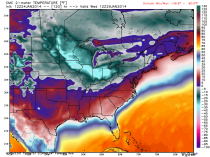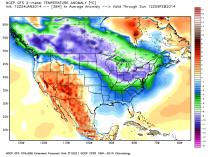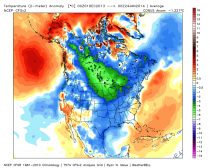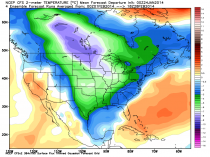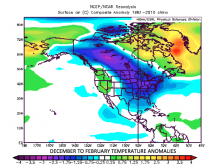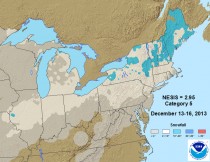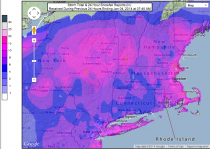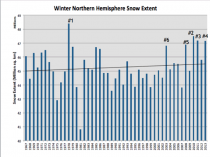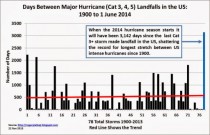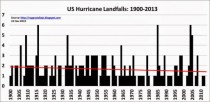Note: See also ”Will The Overselling Of Global Warming Lead To A New Scientific Dark Age?” in Forbes by Dr. Pat Michaels.
Will the overselling of climate change lead to a new scientific dark age? That’s the question being posed in the latest issue of an Australian literary journal, Quadrant, by Garth Paltridge, one of the world’s most respected atmospheric scientists.
Paltridge was a Chief Research Scientist with the Commonwealth Scientific and Industrial Research Organization (CSIRO). The latter is Australia’s equivalent of the National Science Foundation, our massive Federal Laboratory network, and all the governmental agency science branches rolled into one.
Paltridge lays out the well-known uncertainties in climate forecasting. These include our inability to properly simulate clouds that are anything like what we see in the real world, the embarrassing lack of average surface warming now in its 17th year, and the fumbling (and contradictory) attempts to explain it away.
--------
By Marita Noon, Townhall.com
The current cold covering a large portion of the country has, once again, brought out the climate change alarmists with claims of “serious threat.”
Due to his respected position, as climate scientist at the University of California, San Diego Institution of Oceanography, Richard C.J. Somerville’s recent “Cold comfort” column was published in newspapers throughout the country.
In it, he grouses that the public doesn’t take the “consequences” of climate change seriously - pointing out that they are “here and now.” He cites: “only 54 percent of the public sees it as a global threat to their countries and only 40 percent of Americans do.”
Somerville suggests: “people either are scientifically illiterate or reject science when it conflicts with their core values or religious convictions.” He posits: “the medical profession and communication experts may have much to teach those climate scientists” because “Priming patients to appreciate the value of medical diagnostic tests has been shown to make them more likely to take these tests and then act on the results.”
What Somerville misses in the analogy is that the data back up the medical case. For example, getting a mammogram catches breast cancer early and increases survival rates. The data have shown that medical science is correct.
On the contrary, the data don’t support the claims made by climate scientists- but they just keep making them. Apparently they believe the “big lie” propaganda technique used so effectively by Adolf Hitler.
In Somerville’s column, he offers several familiar, easily disproven statements:
* “Low-lying areas are threatened by sea-level rise” which will result in “millions of environmental refugees” and
* “Major threats to agricultural productivity as rainfall patterns change and as heat waves, floods, droughts and other weather extremes worsen.”
Because my expertise is in communications not climate, I reached out to someone who could help me: Robert Endlich - who does in fact have both the education and experience. Endlich, who served as a USAF weather officer for 21 years and holds a BS in geology and an MS in meteorology, offered me pages of data and documentation, which I’ve summarized for my readers.
Environmental Refugees
If the threat of “environmental refugees” sounds familiar, it should. The 2005 UN Environmental Program forecast 50 million to 100 million climate refugees. A UN report by Norman Myers: “Environmental Refugees, an Emergent Security Issue,” presented at the 13th Economic Forum, in Prague, May 23-27, 2005, predicted: “The environmental refugees total could well double between 1995 and 2010,” and “When global warming takes hold, there could be as many as 200 million people overtaken by disruptions of monsoon systems and other rainfall regimes, by droughts of unprecedented severity and duration, and by sea-level rise and coastal flooding.” His report was accompanied by a map, indicating areas to be impacted by sea-level rise.
In early 2011, Gavin Atkins asked: “What happened to the climate refugees?” In his Asian Correspondent post, he used census records to show that the populations in the low-lying areas predicted to “flee a range of disasters including sea level rise” had actually grown - including no fewer than the top six of the very fastest growing cities in China.
Based on both in-person observation and historic evidence from Western Europe, Endlich has made a study of sea level rise. Citing geological features such as stream meanders upstream of Pisa on the Arno River and new shorelines on the coast of the Ligurian Sea, and history, he told me: “What may be news to many is that there is widespread evidence in the Mediterranean Basin and the English Channel coast that sea levels in Roman and Medieval periods were significantly higher than at present. The Roman port of Ostia Antica, the port at Ephesus, now in Turkey, and Pisa have histories showing the Mediterranean Seas significantly higher than today’s sea levels.”
Endlich continued: “In 1066, William the Conqueror defeated King Harold at the Battle of Hastings. Less well-known is when William landed, he first occupied an old Roman fort now known as Pevensey Castle, which at the time was located on a small island in a harbor on England’s south coast. A drawbridge connected castle to mainland. Pevensey is infamous because unfortunate prisoners were thrown out this “Sea Gate,” so that their bodies would be washed away by the tide. Pevensey Castle is now a mile from the coast - further proof of higher sea levels fewer than 1000 years ago.”
The glacial-interglacial temperature data from the past 400,000 years shows each of the previous four interglacials significantly warmer than at present. In fact, a careful analysis of the ice cores from East Antarctica, published as a letter in Nature, shows that maximum temperatures from previous interglacials were at least 6C/10F warmer than present-day temperatures, with CO2 values then about 280 PPM, and today’s values near 400 PPM. Leaving one to ask: “if CO2 is such a strong cause of warming, why is it so cold today?”
Worsening weather extremes
Somerville stated: “The consequences include major threats to agricultural productivity as rainfall patterns change and as heat waves, floods, droughts, and other weather extremes worsen.” Endlich shared the following with me:
Heat Waves: Dr. Judith Curry, Chair of the School of Earth and Atmospheric Sciences at the Georgia Institute of Technology offered Senate testimony on January 16, 2014. She showed an analysis of 982 stations from the U.S. Historical Climate Network for the 48 continental states with more than 80 years of record. The data show a strong peak of record maximum daily temperatures occurred in the 1930s, with no increasing trend in the post-WWII years when CO2 started its modern increase.
Of the 50 states, the number of state maximum record temperatures obtained from NOAA’s National Climate Data Center, by decade, shows that in the 1930s, 23 states set their all-time high temperatures, by far the largest number of such record highs. There has not been a single state record maximum set in the 21st Century.
Droughts: The most-often used indicator of drought is the Palmer Drought Severity Index. Curry’s testimony included a PDSI chart, showing the most severe droughts in the 102-year record 1910-2012, were in the 1930s and a lesser maximum in the 1950s. Data show no indication that drought severity has increased as CO2 has increased.
Floods: Dr. Roger Pielke, Jr., from the University of Colorado, testified to the Senate EPW Committee on July 18, 2013. With respect to floods, he provided data from the US Geological Survey, which show in the U.S., floods have not increased in frequency or intensity since at least 1950, and that flood losses, as a percentage of GDP have dropped by about 75% since 1940, based on data from NOAA’s Hydrologic Information Center.
Somerville says that increasing CO2 will harm plant productivity, but the opposite is true. First, realize that both plants and animals, including humans, are carbon-based life forms. With increasing CO2, there is an incredible array of beneficial effects spelled out in the book, The Many Benefits of Atmospheric CO2 Enrichment, by Craig Idso and Sherman Idso. The benefits include: increasing water-use efficiency; increasing biomass in roots, stems, flowers and nectar; larger seeds; avoiding human starvation and plant and animal extinctions; stimulating early plant growth; and resistance to plant diseases. The carbohydrates we consume when we eat are derived directly from CO2 in the atmosphere; carbohydrates are the source of the energy we need to survive and thrive.
Climate scientists, such as Somerville, do have something to learn from the medical profession: if you want people to heed your warnings, they need to be backed up by the data.
Somerville’s climate refugees cannot be found. In the recent past, interglacial periods were at least 6C/10F warmer than the present with a lot less CO2 in the air; and the Minoan, Roman and Medieval Warm periods were significantly warmer than at present. By historic accounts, sea levels were many feet higher as recently as 1066 and 1300 AD. His claims of heat waves, floods, drought and agricultural disruption are easily disproven by looking at real-world data.
Somerville’s argument points out: “climate change does involve serious threats.” The serious threat is the Obama/Podesta partnership pushing the executive order pen to punish people with new policies that kill jobs and increase energy costs all in the name of saving the planet.
I recall when Jerome Namias, a real scientist with no political agenda was Director of Scripps and it was a respectable institution. Jerome would never make claims that were not well founded in data. Somerville lives in a virtual world of model forecast data. Real data is never really considered.
By Craig D. Idso, Ph.D. SPPI Blog
In his State of the Union address, President Obama advocated an energy policy aimed at reducing emissions of carbon dioxide (CO2), which he claims are causing catastrophic changes to the earth’s climate and “harming western communities.” In his policy prescription, the president advocates a combination of increased regulation of the energy and transportation industries and more government spending on research designed to bring low-carbon-emitting sources of energy, i.e., so-called renewables, to market. He considers those actions to be the only viable options “leading to a cleaner, safer planet.”
But the president’s concerns for the planet are based upon flawed and speculative science; and his policy prescription is a recipe for failure.
With respect to the science, Obama conveniently fails to disclose the fact that literally thousands of scientific studies have produced findings that run counter to his view of future climate. As just one example, and a damning one at that, all of the computer models upon which his vision is based failed to predict the current plateau in global temperature that has continued for the past 16 years. That the earth has not warmed significantly during this period, despite an 8 percent increase in atmospheric CO2, is a major indictment of the models’ credibility in predicting future climate, as well as the president’s assertion that debate on this topic is “settled.”
Numerous other problems with Obama’s model-based view of future climate have been filling up the pages of peer-reviewed science journals for many years now, as evidenced by the recent work of the Nongovernmental International Panel on Climate Change, which published a 1,000-page report in September highlighting a large and well-substantiated alternative viewpoint that contends that rising atmospheric CO2 emissions will have a much smaller, if not negligible, impact on future climate, while generating several biospheric benefits.
Concerning these benefits, atmospheric CO2 is the building block of plant life. It is used by earth’s plants in the process of photosynthesis to construct their tissues and grow. And as has been conclusively demonstrated in numerous scientific studies, the more CO2 we put into the air, the better plants grow. Among other findings, they produce greater amounts of biomass, become more efficient at using water, and are better able to cope with environmental stresses such as pollution and high temperatures.

The implications of these benefits are enormous. One recent study calculated that over the 50-year period ending in 2001, the direct monetary benefits conferred by the atmospheric CO2 enrichment of the Industrial Revolution on global crop production amounted to a staggering $3.2 trillion. And projecting this positive externality forward in time reveals it will likely bestow an additional $9.8 trillion in crop production benefits between now and 2050.
By ignoring these realities, Obama’s policy prescription is found to be erroneous. The taxation or regulation of CO2 emissions is an unnecessary and detrimental policy option that should be shunned. Why would any government advocate to increase regulations and raise energy prices based on flawed computer model projections of climate change that will never come to pass? Why would any government advance policy that seeks to destroy jobs, rather than to promote them? Why, in fact, would they actually “bite the hand that feeds them?”
We live in a time when half the global population experiences some sort of limitation in their access to energy, energy that is needed for the most basic of human needs, including the production of clean water, warmth, and light. One-third of those thus impacted are children. An even greater portion finds its ranks among the poor.
As a society, it is time to recognize and embrace the truth. Carbon dioxide is not a pollutant. Its increasing concentration only minimally affects earth’s climate, while it offers tremendous benefits to the biosphere. Efforts to regulate and reduce CO2 emissions will hurt far more than they will help.
Idso is lead editor and chief scientist for the Nongovernmental International Panel on Climate Change
EPA’s Wood-Burning Stove Ban Has Chilling Consequences For Many Rural PeopleBy Dr. Larry Bell, Forbes (reprinted with permission of author)
Icecap note: Because of regulations already enacted without congressional action by the EPA fully 89% of the coal fired plants in the US will be decomissioned by the end of 2014. They are running flat out to meeting our energy needs. Many people in the north rely on wood stoves to warm their homes or supplement the expensive heating oil and now natural gas and to get through the power outages after ice storms that can go on for weeks. This EPA overreach will result in more deaths and damage (frozen pipes etc) in upcoming winters. You need to speak out.
It seems that even wood isn’t green or renewable enough anymore. The EPA has recently banned the production and sale of 80 percent of America’s current wood-burning stoves, the oldest heating method known to mankind and mainstay of rural homes and many of our nation’s poorest residents. The agency’s stringent one-size-fits-all rules apply equally to heavily air-polluted cities and far cleaner plus typically colder off-grid wilderness areas such as large regions of Alaska and the American West.
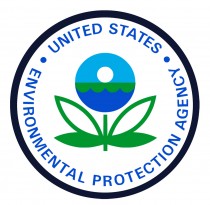
(Photo credit: DonkeyHotey)[/caption]
While EPA’s most recent regulations aren’t altogether new, their impacts will nonetheless be severe. Whereas restrictions had previously banned wood-burning stoves that didn’t limit fine airborne particulate emissions to 15 micrograms per cubic meter of air, the change will impose a maximum 12 microgram limit. To put this amount in context, EPA estimates that secondhand tobacco smoke in a closed car can expose a person to 3,000-4,000 micrograms of particulates per cubic meter.
Most wood stoves that warm cabin and home residents from coast-to-coast can’t meet that standard. Older stoves that don’t cannot be traded in for updated types, but instead must be rendered inoperable, destroyed, or recycled as scrap metal.
The impacts of EPA’s ruling will affect many families. According to the U.S. Census Bureau’s 2011 survey statistics, 2.4 million American housing units (12 percent of all homes) burned wood as their primary heating fuel, compared with 7 percent that depended upon fuel oil.
Local LOCM - 0.89% governments in some states have gone even further than EPA, not only banning the sale of noncompliant stoves, but even their use as fireplaces. As a result, owners face fines for infractions. Puget Sound, Washington is one such location. Montreal, Canada proposes to eliminate all fireplaces within its city limits.
Only weeks after EPA enacted its new stove rules, attorneys general of seven states sued the agency to crack down on wood-burning water heaters as well. The lawsuit was filed by Connecticut, Maryland, Massachusetts, New York, Oregon, Rhode Island and Vermont, all predominately Democrat states. Claiming that EPA’s new regulations didn’t go far enough to decrease particle pollution levels, the plaintiffs cited agency estimates that outdoor wood boilers will produce more than 20 percent of wood-burning emissions by 2017. A related suit was filed by the environmental group Earth Justice.
Did EPA require a motivational incentive to tighten its restrictions? Sure, about as much as Br’er Rabbit needed to persuade Br’er Fox to throw him into the briar patch. This is but another example of EPA and other government agencies working with activist environmental groups to sue and settle on claims that afford leverage to enact new regulations which they lack statutory authority to otherwise accomplish.
“Sue and settle” practices, sometimes referred to as “friendly lawsuits”, are cozy deals through which far-left radical environmental groups file lawsuits against federal agencies wherein court-ordered “consent decrees” are issued based upon a prearranged settlement agreement they collaboratively craft together in advance behind closed doors. Then, rather than allowing the entire process to play out, the agency being sued settles the lawsuit by agreeing to move forward with the requested action both they and the litigants want.
And who pays for this litigation? All-too-often we taxpayers are put on the hook for legal fees of both colluding parties. According to a 2011 GAO report, this amounted to millions of dollars awarded to environmental organizations for EPA litigations between 1995 and 2010. Three “Big Green” groups received 41% of this payback, with Earthjustice accounting for 30 percent ($4,655,425). Two other organizations with histories of lobbying for regulations EPA wants while also receiving agency funding are the American Lung Association (ALA) and the Sierra Club.
In addition, the Department of Justice forked over at least $43 million of our money defending EPA in court between 1998 and 2010. This didn’t include money spent by EPA for their legal costs in connection with those rip-offs because EPA doesn’t keep track of their attorney’s time on a case-by-case basis.
The U.S. Chamber of Commerce has concluded that Sue and Settle rulemaking is responsible for many of EPA’s “most controversial, economically significant regulations that have plagued the business community for the past few years”. Included are regulations on power plants, refineries, mining operations, cement plants, chemical manufacturers, and a host of other industries. Such consent decree-based rulemaking enables EPA to argue to Congress: “The court made us do it.”
Directing special attention to these congressional end run practices, Louisiana Senator David Vitter, top Republican on the Senate Environment and Public Works Committee, has launched an investigation. Last year he asked his Louisiana Attorney General Buddy Caldwell to join with AGs of 13 other states who filed a Freedom of Information Act (FOIA) seeking all correspondence between EPA and a list of 80 environmental, labor union and public interest organizations that have been party to litigation since the start of the Obama administration.
Other concerned and impacted parties have little influence over such court procedures and decisions. While the environmental group is given a seat at the table, outsiders who are most impacted are excluded, with no opportunity to object to the settlements. No public notice about the settlement is released until the agreement is filed in court...after the damage has been done.
In a letter to Caldwell, Senator Vitter wrote: “The collusion between federal bureaucrats and the organizations entering consent agreements under a shroud of secrecy represents the antithesis of a transparent government, and your participation in the FOIA request will help Louisianans understand the process by which these settlements were reached.”
Fewer citizens would challenge EPA’s regulatory determinations were it not for its lack of accountability and transparency in accomplishing through a renegade pattern of actions what they cannot achieve through democratic legislative processes.
A recent example sets unachievable CO2 emission limits for new power plants. As I reported in my January 14 column, a group within EPA’s own Science Advisory Board (SAB) determined that the studies upon which that regulation was based had never been responsibly peer reviewed, and that there was no evidence that those limits can be accomplished using available technology.
Compared with huge consequences of EPA’s regulatory war on coal, the fuel source that provides more than 40 percent of America’s electricity, a clamp-down on humble residential wood-burning stoves and future water heaters may seem to many people as a merely a trifling or inconsequential matter. That is, unless it happens to significantly affect your personal life.
As a Washington Times editorial emphasized, the ban is of great concern to many families in cold remote off-grid locations. It noted, for example, that “Alaska’s 663,000 square miles is mostly forestland, offering residents and abundant source of affordable firewood. When county officials floated a plan to regulate the burning of wood, residents were understandably inflamed.”
Quoting Representative Tammie Wilson speaking to the Associated Press, the Times reported: “Everyone wants clean air. We just want to make sure that we can also heat our homes” Wilson continued: “Rather than fret over EPA’s computer model based warning about the dangers of inhaling soot from wood smoke, residents have more pressing concerns on their minds as the immediate risk of freezing when the mercury plunges.”
And speaking of theoretical computer model-based warnings, where’s that global warming when we really need it?
Tuesday evening President Obama will present his State of the Union to the nation on one of the coldest nights in years. All 50 (57?) states will see sub freezing temperatures. Up to 30 states will have temperatures drop below zero F!
Snow will be falling from near Houston to New Orleans, the Florida Panhandle and the coastal Carolinas. Models suggest Charleston, SC may get over 7 inches of snow, some models have a foot.
Maps available on Weatherbell.com
Charleston, SC’s modern record snowstorm is 6.6 inches in 1989. Some models exceed or even double that. In 2010, 3.4 inches (8.6 cm) fell on the evening of February 12, the heaviest in 20 years. The record for Charleston was in January 9-11, 1800 when 8.1 inches fell. 7.1 inches fell on February 9-10, 1973.
The nation is suffering from a serious propane shortage and with heavy icing on the nation’s lakes and rivers slowing or stalling barge traffic for grains and fuels. The President will no doubt reassure his green supporters he will continue his war on fossil fuels and support for alternative energy to fight the ravages of global warming. Despite any promises that renewables will save the middle class money, the EPA if not reigned in will cause the prices of electricity, natural gas and fuel oil to in Obama’s own words “necessarily skyrocket’. Suppliers might not have supplies to sell you as we saw in places early in January and may see this week/next month. Blackouts and brownouts will become more common in the years head. Unemployment will go up as it did in Spain (27.5%). All these problems have been experienced in Europe, where they are running as fast as they can away from the green agenda. We aren’t learning from their mistakes. The EPA is running rampant and the senate is proposing legislation to force unreasonable renewable energy standards.
The Gore effect lives on. The lunacy continues.
----------
SOTU, 2014: Obama will use wintry weather as example of global warming
January 26th, 2014 by Roy W. Spencer, Ph. D.

I predict that, despite the brutally cold weather in DC this Tuesday, Obama will preach on climate change in his State of the Union address. I predict he will even use the cold weather as evidence to support his case.
During his address it looks like there will be a wintry mix starting across the southern reaches of Louisiana, Mississippi, Alabama, Georgia, the Carolinas, and the Florida panhandle. I wouldn’t be surprised if he uses the event as evidence of human-caused climate change.
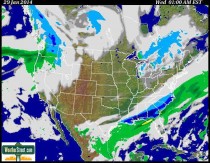
Precip and cloud forecast for around midnight, Tuesday night.
For those of us old enough to remember, similar events happened back in the epic cold winters of the 1970s. Many instances of snow falling in Florida in the 1800s surely weren’t due to humans. Believe it or not, more snow tends to go with colder weather, not warmer. Go figure.

Snowball fight on the steps of the Florida capitol building, Feb. 10, 1899.
Has everyone forgotten that the global warming prophets predicted winters without snow?
And there is no credible evidence that climate change (induced by global warming) can produce colder than normal temperatures. There has been no long-term change in mid-latitude storminess. One climate model out of a hundred might produce colder weather over less than 1% of the Earth with global warming....those are damn long odds to hang your hat on.
But you know that if this winter was 20 deg. above normal rather than below normal, that would be used as evidence of global warming. Some people want to have it both ways. That sounds to me more like political spin than science.
Still, I’m sure the President can find a few scientists who will support him. So he’s covered.
Yes, we live in interesting times.
On January 6, we wrote
“After a couple more cold days, moderation will take place but note that winter when the cold does this, it often repeats and models indicate it may after 10 days, probably extending a little further east. Join us at weatherbell.com and read about the threat. We correctly forecast this cold winter and this outbreak many days in advance.”
Well for the last several week we have been telling subscribers commercial clients for over the last two plus week that that cold reprise was coming. That cold has started and unlike the early month cold will keep on coming in waves with the cold early next week probably COLDER than that with the now famous ‘polar vortex’. Here is the forecast anomaly for the next 8 days:
Temperatures are forecast by the model 30F below normal and well below zero into the midwest shattering long term records. I would not be surprised to see lows of 40 to 50F below zero in Minnesota and 20 to 30 below in the Ohio Valley where the coldest air is forecast to settle. That is not wind chill but actual temperatures.
The cold doesn’t end then though the core may shift west and northwest again while it reloads. The following period may be characterized by big storms. The next week will feature fast moving ‘clipper’ storms the bring in fresh cold. The southern storm track may be activated by changes in the tropical Pacific. with the potential for a snowstorm between the 3rd and 6th of February. Here are the week 2 anomalies - still well below normal. Chicago, Philadelphia and NYC have already exceeded there normal seasonal snowfall and more is coming.
This is the anomaly so far this season.
Note it is 1.22C below normal for the lower 48 states. If that persists through February (and the models are cold for February, the winter would rank with the cold winters of the late 1970s. I have aded that to the NCDC graph of winter CONUS temperature anomalies. Of course NOAA has its magic adjustments it makes to the actual data so we will see. This analysis is based on actual observations that go in to the forecast models 4 times daily.
Here is the CFS model February forecast,
At Weatherbell, we saw this winter coming months ago. Here is a forecast issued in the fall to clients in our ag service. It is based on our own proprietary multivariate statistical model approaches. We have expanded inputs into the approach and have been hitting it out of the park this past year.
Joe Bastardi had a similar forecast for the energy clients and last week when one operational 16 day forecast model run suggested the cold broke, JB told our clients NO and indeed the market has soared when all the models came back to a cold solution. The energy market sold off but then went into panic buying mode. Our client made money.
Please join us at Weatherbell and you will get our insights and forecast, videos and Dr. Ryan Maue’s superior model graphics and value added products. JB and I have been posting and forecasting for the markets daily since March 2011 at Weatherbell. Not only can you find superior temperature forecasts, but we have hit every major snowstorm, hurricane and tornado outbreak event many days in advance. If you have a weather sensitive business, you cant afford to rely on the unreliable model based point and click on the internet nor the model hugging forecast services. You need dependable guidance and hand holding. (Weatherbell.com)
By the way, the impact of this coming cold will be far reaching. the Great Lakes ice will increase to levels of 1993/94 or greater. Great Lakes barge traffic and barge traffic on our major rivers will be stopped by ice. Look for the Potomac, Hudson, parts of New York Harbor to freeze. The chart below shows the ice coverage in % (black is 100% coverage, white open water, greys partial ice).
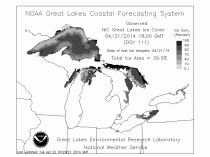
Enlarged
By: Lachlan Markay, Washington Free Beacon, January 15, 2014 2:47 pm
Internal Environmental Protection Agency (EPA) emails show extensive collaboration between top agency officials and leading environmentalist groups, including overt efforts to coordinate messaging and pressure the fossil fuel industry.
The emails, obtained by the Energy and Environment Legal Institute (EELI) through a Freedom of Information Act lawsuit, could fuel an ongoing controversy over EPA policies that critics say are biased against traditional sources of energy.
Emails show EPA used official events to help environmentalist groups gather signatures for petitions on agency rulemaking, incorporated advance copies of letters drafted by those groups into official statements, and worked with environmentalists to publicly pressure executives of at least one energy company.
Nancy Grantham, director of public affairs for EPA Region 1, which covers New England, asked an organizer for the Sierra Club’s New Hampshire chapter to share the group’s agenda so EPA could adjust its messaging accordingly in an email dated March 12, 2012.
“If you could, it would great [sic] if you can send me an email describing what you would like to do in early April in NH that way I can coordinate messaging with our air offices here and at HQ,” Grantham wrote.
Critics of the agency and its nonprofit allies were surprised by the cooperation.
“The level of coordination in these documents is shocking,” EELI said in a statement.
Rep. Mike Pompeo (R., Kan.), a member of the Energy and Commerce Subcommittee on Energy and Power, said the emails suggest that the EPA is straying from its mission by working hand-in-hand with hardline green groups.
“It’s unfortunate that EPA has spent more of its resources promoting and coordinating a political agenda with environmentalists instead of doing its job,” Pompeo said in an emailed statement.
“In Kansas, we expect public officials to serve the public interest, not the interests of radical environmentalist groups.”
The documents also reveal some of the internal deliberations behind recent controversial EPA decisions, such as the locations of public hearings on an agency rule imposing stringent emissions limits for power plants.
The agency came under fire from legislators representing coal-producing states for holding those hearings far from regions where most of the nation’s coal is produced.
“Instead of the EPA holding a coal hearing in the heart of Coal Country, Kentucky, he has chosen locations such as San Francisco and Washington, D.C.,” Senate Minority Leader Mitch McConnell (R., Ky.) said at the time.
McConnell accused EPA of “once again showing its contempt for Kentucky’s coal miners and their families.”
Emails released by EELI show that EPA decided on the locations for those hearings after consulting with leading environmentalist groups that advocate the complete phase-out of coal power.
“San Fran and Seattle would be friendlier forums but CA has no coal plants and WA is phasing out its one plant,” noted EPA region 8 administrator James Martin in an email to Vicki Patton, general counsel at the Environmental Defense Fund (EDF).
“Choosing either may create opportunities for the industry to claim EPA is tilting the playing field,” Martin told Patton. “Denver would not have that problem.”
The EPA would later deny that Martin used a personal email for EPA business. The FOIAed messages reveal that that was not the case. His email to Patton was sent from a “.me” address.
Martin also advised Patton that hearings in Denver could be used to pressure the natural gas industry. “The gas industry has way more presence here, too. One last point in its favor it will make Roy Palmer nervous!” he wrote.
Palmer is an executive at Xcel Energy, a leading natural gas utility in Colorado.
Amy Oliver Cooke, the executive director of the Independence Institute, a Denver-based free market think tank, said she was surprised at the hostility towards Palmer and Xcel, given their past cooperation on legislation imposing renewable energy quotas in the state.
“It shows that Xcel and natural gas aren’t welcome at the eco-left’s cool kids table anymore,” Cooke said.
“It’s really no surprise,” she added. “We warned them they would be next. When you sleep with rattlesnakes eventually they will bite you. With friends like Patton and Martin, Xcel and natural gas don’t need any more enemies.”
A Sierra Club employee also sent a list of their preferred locations for public hearings. The list was forwarded to EPA staff.
The emissions rule on which EPA held those hearings - one of which ended up taking place in Denver - is expected to effectively block the construction of new coal-fired power plants.
The EPA has denied that that was the purpose of the rule, or that it will have that effect. However, other emails obtained by EELI show that top EPA officials were aware that it would devastate the industry.
These newly released emails show that officials also used events surrounding the rule to help environmentalist groups gather public comments on the rulemaking process that supported the EPA’s position.
Deputy EPA administrator Bob Perciasepe attended an April 24, 2012, meeting with 24 leading environmentalist groups, including EDF, the Sierra Club, and the Natural Resource Defense Council, according to a notice of the meeting sent by Teri Porterfield, Perciasepe’s assistant. “The purpose is to create a photo-op and narrative beat for the comment-gathering efforts on the issue,” Porterfield wrote.
“Groups will use materials from the event to communicate with supporters and recruit additional comment-signers via newsletters, emails, and social media,” she added.
The EPA also incorporated environmentalist groups’ messaging into then-administrator Lisa Jackson’s communications with members of Congress, the emails reveal.
On November 30, 2011, John Coequyt, who headed the Sierra Club’s “beyond coal” campaign, sent an advance copy of a letter publicly released the following day to a number of EPA officials, including “Richard Windsor,” the pseudonym Jackson used for her personal email address.
The letter addressed a pending EPA rule on emissions from industrial boilers.
“Administrator, I’ll summarize all this in your briefing document for the Hill meetings regarding Boiler MACT,” Arvin Ganesan, a top official in EPA’s congressional relations office, wrote in a follow-up. The following paragraphs of Ganesan’s email were redacted by EPA’s FOIA office.
These emails were released weeks after EPA’s inspector general released a report examining apparent coordination between the agency and environmentalist groups prior to EPA issuing an endangerment order against Texas natural gas company Range Resources.
The IG found that EPA’s actions “conformed to agency guidelines, regulations and policy,” but observers say it either failed to take into account significant pieces of evidence or deliberately ignored that evidence.
Internal EPA regulations prohibit officials from leaking information about administrative orders prior to their public release. However, the IG said that the EPA had done no such thing with respect to the Range order.
“A review of the evidence showed that this communication occurred after the region issued its press release and that it is not out of the ordinary for the EPA to inform interested parties of press releases after they are released,” the report stated.
That statement seems to contradict evidence showing that Al Armendariz, a former EPA region 6 administrator infamous for comparing his enforcement philosophy to Roman crucifixions, gave environmentalist groups the heads up before EPA put out its press release.
“We’re about to make a lot of news,” Armendariz wrote to a handful of Texas environmental activists prior to that release. “There’ll be an official press release in a few minutes. Also, time to Tivo channel 8.”
By Greg Campbell
Is global warming real? Despite what Al Gore has repeatedly claimed, the debate is far from “over.” As much of the country deals with plunging temperatures, with some states experiencing temperatures in the -20’s and -30’s, the politically-charged issue of global warming, or “climate change” to those who favor a catch-all phrase to explain any kind of weather fluctuation, has emerged once again.
Scientists on both sides of the issue are battling it out and scientists and political pundits on the left are scrambling to try and explain the cold weather as a sign of, you guessed it, global warming.
TIME Magazine recently denounced skeptics in an article entitled, “Polar Vortex: Climate Change Could Be the Cause of Record Cold Weather.” Bryan Walsh wrote,
“But not only does the cold spell not disprove climate change, it may well be that global warming could be making the occasional bout of extreme cold weather in the U.S. even more likely. Right now much of the U.S. is in the grip of a polar vortex, which is pretty much what it sounds like: a whirlwind of extremely cold, extremely dense air that forms near the poles.”
That would be, perhaps, an understandable explanation if TIME Magazine and other assorted leftist, agenda-driven journals had not already made claims to the contrary. In 1974, TIME Magazine, the same magazine that blamed the cold on global warming, blamed the cold on “global cooling.” In a June 24th, 1974, article entitled, “Another Ice Age?” the magazine claimed,
“Scientists have found other indications of global cooling. For one thing there has been a noticeable expansion of the great belt of dry, high-altitude polar winds -the so-called circumpolar vortex - that sweep from west to east around the top and bottom of the world.”
It’s not just TIME that cherry-picks their explanations for the cold streak; with the emergences of ‘’green” technologies and the billions of dollars being made in the field of advancing environmentally-friendly products and services, it is undeniable that there remains a strong motive for many to ensure that “global warming” or “climate change” not only exists, but that it is a man-made problem.
The industries behind “green” technology do serious business. Gaining money from government grants and guilty liberals, companies that claim to produce products that are less harmful to the environment have a vested interest in the preservation of the idea that global warming exists.
In fact, Al Gore, the guru of the environmental hysterics, allows liberals to assuage their guilt by selling “carbon credits,” modern day indulgences that the hummer-driving liberal can buy to try and offset their carbon footprint. Of course, the biggest beneficiaries of the carbon credits are those selling these environmental pardons, including Al Gore himself.
As scientists work to try and discover the truth behind the divisive issue, the left maintains a policy of intimidation by routinely discrediting skeptics as modern-day heretics. “Consensus science” now dominates the discussion surrounding global warming just as “consensus science” once dominated the discussion surrounding whether the sun rotated the Earth.
When the Earth experiences higher-than-normal temperatures, without fail, the left proclaims it as a result of global warming. When the Earth experiences the exact opposite, a plunging of temperatures, the left warns us that such cold weather is the result of global warming. More tornadoes in a given year, less tornadoes in a given year, more hurricanes, less hurricanes, all thanks to global warming.
However, having noticed this pattern of contradictory language, the left now seems to favor “climate change” as a means to encompass any slight variation in Earth’s conditions.
Global warming may be real and it may not be. If it does exist, we should try and discover if it is man-made or if it is a natural, cyclical pattern the Earth has seen long before man. However, we will never get to the bottom of the issue so long as the left attempts to maintain a stranglehold on the prevailing narrative. With the left hell-bent on tampering with the science behind Earth’s temperatures, the scientific method has been thoroughly contaminated.
So long as companies turn tremendous profits from selling products and services predicated on the notion that global warming is real, the “science” behind it will never be real science.
So long as researchers are dependent upon grants offered by those with a vested interest in proving the existence of man-made global warming, we will never be offered real, legitimately-obtained data extracted through the use of the scientific method.
So long as academia bullies and discredits the scientific heretics who dare to question the validity of the agenda-driven science, we will remain in the dark.
And until the left admits that the debate is far from “over,” we cannot have an honest discussion about global warming, global cooling, climate change or whatever preferred term used to justify the increasingly-absurd, politically-charged narrative.
By Joseph D’Aleo, CCM
It was quite a storm. I have never seen Logan Airport report heavy snow with an air temperature of 1F (not wind chill) before. The ended up with 15.1 inches. Boxford had 23.8 inches.
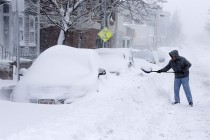
Even as more cold and snow invades the central, near the east coast, the post storm blues have set in with the inevitability of an inside runner following rapidly on its heels. But snow loving friends, we have lived through quite a decade and the millennium so far has been a boon to snow lovers despite the continuing claims that snows are becoming rare and hurting winter sports as erroneously reported last week in Boston Magazine.
We here are using NOAA’s own NESIS scale - which we used to call the Kocin/Uccellini storms.
The Northeast Snowfall Impact Scale (NESIS)
Overview
While the Fujita and Saffir-Simpson Scales characterize tornadoes and hurricanes respectively, there is no widely used scale to classify snowstorms. The Northeast Snowfall Impact Scale (NESIS) developed by Paul Kocin and Louis Uccellini of the National Weather Service (Kocin and Uccellini, 2004) characterizes and ranks high-impact Northeast snowstorms. These storms have large areas of 10 inch snowfall accumulations and greater. NESIS has five categories: Extreme, Crippling, Major, Significant, and Notable. The index differs from other meteorological indices in that it uses population information in addition to meteorological measurements. Thus NESIS gives an indication of a storm’s societal impacts. This scale was developed because of the impact Northeast snowstorms can have on the rest of the country in terms of transportation and economic impact.
NESIS scores are a function of the area affected by the snowstorm, the amount of snow, and the number of people living in the path of the storm. The diagram below illustrates how NESIS values are calculated within a geographical information system (GIS). The aerial distribution of snowfall and population information are combined in an equation that calculates a NESIS score which varies from around one for smaller storms to over ten for extreme storms. The raw score is then converted into one of the five NESIS categories. The largest NESIS values result from storms producing heavy snowfall over large areas that include major metropolitan centers. For details on how NESIS scores are calculated at the National Climatic Data Center, see Squires and Lawrimore (2006).
References:
Kocin, P. J. and L. W. Uccellini, 2004: A Snowfall Impact Scale Derived From Northeast Storm Snowfall Distributions. Bull. Amer. Meteor. Soc., 85, 177-194
Squires, M. F. and J. H. Lawrimore, 2006: Development of an Operational Snowfall Impact Scale. 22nd IIPS, Atlanta, GA.
They had added the mid December storm to the Northeast NESIS list as a category 2 (Significant) event.
The table below is enlarged with hyperlink snow amount VIEW maps here.
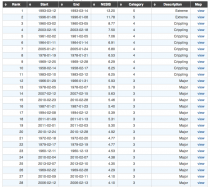
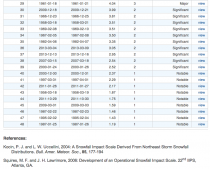
Enlarged Part 1
Enlarged Part 2
This week’s storm was at least as impactful and covered a wide stretch back to the Midwest.
If it joins the NESIS list, it will be storm 49 and make the 2010s the snowiest decade for the east coast in the record, surpassing the 1960s.
Of course we are just beginning the 4th year of the decade. Also note that 21 of the 49 have been this millennium.
As we have shown before, 4 of the top 5 snowiest years have occurred in the last 6 years for the Northern Hemisphere and the snow extent for November to April was the greatest on record.
See PROGRESSIVE DISORDERS FOR ALL THE LINKS TO THE FOLLOWING STORIES THAT CLAIM VICTORY NO MATTER WHAT HAPPENS
Global Warming Means Less Snow.
“The probability of any precipitation falling as snow rather than rain is going to decrease, and any snow lying on the ground is going to melt more quickly,”
LESS SNOW
A Rare and Exciting Event
“Looking at the United States of America, the IPCC clearly warned that unchecked global warming will lead to reduced snow pack in the western mountains, critically reducing access to water, which is our lifeblood.” Senator Barbara Boxer (D)
According to Dr David Viner, a senior research scientist at the climatic research unit (CRU) of the University of East Anglia, within a few years winter snowfall will become “a very rare and exciting event”. “Children just aren’t going to know what snow is,” he said.
Gore’s claim of snow being “consistent: with global warming is also at odds with is Oscar Winning 2006 film “An Inconvenient Truth.” Gore never once warned of record cold and increasing snowfalls as a consequence of man-made global warming in that film. But Gore has hyped the lack of snow as “evidence” for man-made global warming.
“He also remarked that the most optimistic climate models for the second half of this century suggest that 30 to 70% of the snow pack will disappear. Now, no wonder we have people visiting our offices who are just already hurting from the recreation industry in this nation. They see what’s happening.” -Barbara Boxer, October 29th, 2007, on the Senate floor
1 foot less snow in winter? Minnesota Climate Change Forum highlights dramatic changes
Average winter snowfall may drop by as much as 1 foot by 2100 as more winter precip falls as rain in a warmer winter environment.
CTB: less snow, smaller glaciers, thinner ice
Greenpeace: less snow, smaller glaciers, thinner ice.
(Sure I’m mocking them, but they don’t know where I live. -RB)
Reduced Snow Pack
Barbara Boxer 2009: “Looking at the United States of America, the IPCC clearly warned that unchecked global warming will lead to reduced snow pack in the western mountains, critically reducing access to water, which is our lifeblood.”
Decadal to century scale trends in North American snow extent in coupled atmosphere-ocean general circulation models
Our conclusion that these models predict a significant decrease in snow extent over North America during the 21st century is robust, in the sense that all available models agree for two different yet realistic SRES future emissions scenarios, while no model predicts such a decrease for the unrealistic COMMIT scenario.
IPCC: As temperatures rise, likelihood of precipitation falling as rain rather than snow increases
“As temperatures rise, the likelihood of precipitation falling as rain rather than snow increases, especially in autumn and spring at the beginning and end of the snow season, and in areas where temperatures are near freezing. Such changes are observed in many places, especially over land in middle and high latitudes of the Northern Hemisphere, leading to increased rains but reduced snowpacks.” (IPCC)
Global Warming Reducing Snowfall at Ski Resorts
BOULDER, Colo. The hard-pressed American ski resort industry could be facing a serious problem in coming years if European researchers are correct: less snow because of global climate change.
IPCC IV: Decreased Snow season length and snow depth
Snow season length and snow depth are very likely to decrease in most of North America, except in the northernmost part of Canada where maximum snow depth is likely to increase.
...Children just aren’t going to know what snow is…
Warmer world means less snow
Among the warming’s effects: Arid regions will dry out further. And some of the water that they do receive will come in the wrong form (rain instead of snow) or at the wrong time.
Global warming to shorten ski season
CSIRO climate change expert Dr Penny Whetton says Australia’s mountain snow cover could be reduced by up to 54 per cent by 2020. “The probability of any precipitation falling as snow rather than rain is going to decrease, and any snow lying on the ground is going to melt more quickly,” she said.
Warming: Ski Resorts Threatened by Lack of Snow
Like those who rely on the Great Barrier Reef, the Australian ski industry sees itself as a frontline victim of global warming. A 2003 CSIRO report, part-funded by the ski industry, found that the resorts could lose a quarter of their snow in 15 years, and half by 2050. The worst case was a 96 per cent loss of snow by mid-century.
Global Warming Means Less Snow
CAMBRIDGE, Massachusetts, October 4, 2006 (ENS) - Global warming will cause major changes to the climate of the U.S. Northeast if greenhouse gas emissions are not reduced, scientists said today. Warmer annual temperatures, less snow, more frequent droughts and more extreme rainstorms are expected if current warming trends continue, the scientists said in a new study, and time is running out for action to avoid such changes to the climate.
Global Warming: Less Snow
The idea that global warming will bring more rain and less snow goes back to at least 1999, when a University of California, Santa Barbara researcher said “There will be too much water at the wrong time and too little when we need it.”
Democrats: Less Snow = Global Warming
Less snow is what the models predict due to warming.
Snowfalls are now just a thing of the past - Environment - The Independent
Sleds, snowmen, snowballs and the excitement of waking to find that the stuff has settled outside are all a rapidly diminishing part of Britain’s culture, as warmer winters - which scientists are attributing to global climate change - produce not only fewer white Christmases, but fewer white Januaries and Februaries.
Senate Science Caucus: Warming = Less Snow
According to Dr David Viner, a senior research scientist at the climatic research unit (CRU) of the University of East Anglia, within a few years winter snowfall will become “a very rare and exciting event”. “Children just aren’t going to know what snow is,” he said.
MORE SNOW
Global Warming Means More Snow.
“If the climate continues to warm, we should expect an increase in heavy snow events for a few decades.”
They’re snorting more snow.
That snow outside is what global warming looks like
“As it turns out, the scientific community has been addressing this particular question for some time now and they say that increased heavy snowfalls are completely consistent with what they have been predicting as a consequence of man-made global warming.” -Al GoreGlobal warming means more snowstorms: scientists - “Heavy snowstorms are not inconsistent with a warming planet,” said ‘scientist’ Jeff Masters, as part of a conference call with reporters and colleagues convened by the Union of Concerned ‘Scientists’.
John Christy, the Alabama state climatologist who authored the study, said the amount of snow in the mountains has not decreased in the past 50 years, a period when greenhouse gases were supposed to have increased the effects of global warming.
Snowstorms: One More Sign of Climate Change - TIME
One theory is that a warmer Arctic may actually lead to colder and snowier winters in the northern mid-latitudes.
East Coast Blizzard Tied to Climate Change - TIME
Brace yourselves now - this may be a case of politicians twisting the facts. There is some evidence that climate change could in fact make such massive snowstorms more common, even as the world continues to warm.
Warming Planet Can Mean More Snow : NPR
Climate scientists say they can’t prove any single weather event is due to climate change. Thus, they say, Hurricane Katrina or the heat wave in Vancouver that’s dogging the Winter Olympics isn’t proof that climate change is happening. Nor can southern and eastern snowstorms prove that it’s not.
Bundle Up, It’s Global Warming - New York Times
Blizzard: Sign of Global Warming
But while piles of snow blocking your driveway hardly conjure images of a dangerously warming world, it doesn’t mean that climate change is a myth (just a damned lie)
Snow is consistent with global warming, say scientists
Britain may be in the grip of the coldest winter for 30 years and grappling with up to a foot of snow in some places but the extreme weather is entirely consistent with global warming, claim scientists.
Global warming means more snowstorms: scientists
“If the climate continues to warm, we should expect an increase in heavy snow events for a few decades, until the climate grows so warm that we pass the point where it’s too warm for it to snow heavily.”
Al’s Journal: Increased heavy snowfalls
As it turns out, the scientific community has been addressing this particular question for some time now and they say that increased heavy snowfalls are completely consistent with what they have been predicting as a consequence of man-made global warming
Snow is consistent with global warming, say scientists.
Dr. Kaku: Global Warming = More Snow
Dr. Kaku agreed with the suggestion: “‘Yes. It seems to violate common sense, but as the Earth begins to heat up, that means more moist air in the Caribbean and the Gulf of Mexico on average. Which creates more precipitation, and eventually more snow.”
Bundle Up, It’s Global Warming - NYTimes.com
Over the past few weeks, subzero temperatures in Poland claimed 66 lives; snow arrived in Seattle well before the winter solstice, and fell heavily enough in Minneapolis to make the roof of the Metrodome collapse; and last week blizzards closed Europe’s busiest airports in London and Frankfurt for days, stranding holiday travelers. The snow and record cold have invaded the Eastern United States, with more bad weather predicted.
Gore global warming = heavy snow fall
“As it turns out, the scientific community has been addressing this particular question for some time now and they say that increased heavy snowfalls are completely consistent with what they have been predicting as a consequence of man-made global warming,” Gore wrote. Unfortunately for Gore and others who have claimed that the snow this winter is a global warming byproduct, their own authorities have said climate change will result in less snow.
Yes, global warming could mean more snow
In fact, scientists have been warning for at least two decades that global warming could make snowstorms more severe. Snow has two simple ingredients: cold and moisture. Warmer air collects moisture like a sponge until it hits a patch of cold air. When temperatures dip below freezing, a lot of moisture creates a lot of snow.
That snow is what global warming looks like
That snow outside is what global warming looks like: Unusually cold winters may make you think scientists have got it all wrong. But the data reveal a chilling truth…
NO CHANGE
...no evidence that anything has changed as a result of climate change…
Sierra snowfall consistent over 130 years
Snowfall in the Sierra Nevada has remained consistent for 130 years, with no evidence that anything has changed as a result of climate change, according to a study released Tuesday.
4 of the top 5 snowiest years for the Northern hemisphere have occurred in the last 6 years.
By Steve Goreham PDF
Originally published in The Washington Times
_thumb.jpg)
Earlier this month, Representatives Jared Polis (D Colorado), Ben Ray Lujan (D New Mexico), and Ann Kuster (D New Hampshire) introduced the National Renewable Electricity Act of 2013 (RES Act), into the US House of Representatives. The act mandates that all US retail electrical suppliers buy an increasing amount of electricity from renewable energy sources, or pay fines for the shortfall. But if the law is passed, it will raise electricity prices for Americans for questionable environmental gains.
The act calls for solar, wind, biomass, geothermal, and other renewables to provide 6 percent of US electricity in 2014, rising to 25 percent by the year 2025. Representative Kuster says, “This common-sense bill will help create good middle class jobs, cut pollution and reduce our dependence on foreign oil-all while saving consumers money on their utilities.” Unfortunately, Ms. Kuster’s statement is not supported by actual industry experience and economic data.
Forcing consumers to buy a product that is more expensive, like renewable energy, never saves them money. A prime example is the recently completed California Valley Solar Ranch in San Luis Obispo County that was constructed under the 33 percent renewables mandate of California’s Renewable Portfolio Standards (RPS) law. The solar ranch covers a huge area of 1,500 acres, more than 100 times the area of a typical natural gas-fired power plant, but produces an average output of only about 55 megawatts, less than one-tenth the output of a typical gas-fired plant, at the exorbitant price of $1.6 billion.

Consumers will pay twice for the California Valley Solar Ranch. Electricity from the ranch will be priced at 15 to 18 cents per kilowatt-hour, four times the price of current California wholesale electricity and over 50 percent more than projected prices during the next 25-years. Consumers also paid for a tax subsidy package totaling $1.4 billion, including a 30 percent federal investment tax credit worth $462 million, a $1.2 billion US Department of Energy loan guarantee worth $205 million, and other tax benefits.
Representative Kuster’s comments about reducing “our dependence on foreign oil” are nonsense. Today only 0.7 percent of US electricity comes from petroleum. Claiming that a national renewable electricity standard will reduce foreign oil imports is about accurate as claiming that it will promote world peace.
Politicians repeatedly state that subsidies and mandates for renewable energy will produce “green jobs.” But the Beacon Hill Institute developed more than ten studies on the impacts of state RPS laws, including Colorado and New Mexico, the home states of Representatives Polis and Lujan. In all cases, the implementation of RPS laws was found to increase electricity prices, reduce real disposable income, reduce investment, and cause a net reduction in jobs.
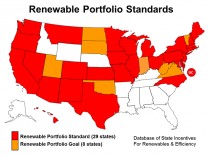
Today, 29 states follow renewable portfolio standards laws and another 8 states pursue renewables goals for electricity. The sponsors of the RES Act want to force mandates on the remaining 13 states, the only states with a sensible energy policy. Note that in 2012, citizens in states without RPS mandates paid 10.7 cents per kw-hr for residential electricity, about 19 percent less than the 12.7 cents per kw-hr paid by citizens in states with RPS laws or goals. Higher electricity prices disproportionately impact the poor, as a larger part of their family budget.
Neither is a reduction in pollution a good reason for a national renewable electricity standard. According to Environmental Protection Agency data, all real air pollutants, including lead, ozone, nitrous oxides, sulfur oxides, and carbon particulates have been falling for more than 40 years and continue to decline. US air pollution levels have fallen an aggregate 72 percent since 1970. At the same time, US electricity production from coal is up 115 percent and from natural gas is up 230 percent.
The unmentioned reason for the RES Act is to reduce emissions of carbon dioxide, the greenhouse gas blamed for man-made global warming. But carbon dioxide, a harmless, invisible gas that trees use for photosynthesis, has been wrongly labeled a pollutant. By forcing the construction of expensive wind and solar plants, proponents of the theory of dangerous climate change believe that they can save polar bears, reduce the strength of storms, curb droughts and floods, and probably promote world peace.
But RPS laws don’t even reduce emissions of carbon dioxide. Installation of wind systems creates stop-and-go electrical utilities. Output from wind turbines is erratic, forcing back-up coal and natural gas plants to inefficiently ramp power up and down to maintain continuity of energy supply. Studies of utilities in Netherlands and Colorado show that combined wind and hydrocarbon systems use more fuel and emit more CO2 than stand-alone hydrocarbon-fired plants.
Rather than enacting a national renewable electricity law, we should instead roll back our costly state RPS laws. Suppose we return to energy policy based on economics and common-sense, rather than global warming ideology?
Steve Goreham is Executive Director of the Climate Science Coalition of America and author of the book The Mad, Mad, Mad World of Climatism: Mankind and Climate Change Mania.
By Charles Battig, MD, Virginia Free Citizen
The school lunch program is a resounding success here in Albemarle County, Virginia. School kids are awash in food; no child is left behind in the new standards-of-lunch excesses.
As reported in Charlottesville on December 5, 2013:
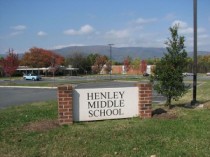
“Albemarle County Public Schools is conserving energy and teaching students green lessons while doing so. At its annual conference in Williamsburg, the Virginia School Boards Association honored Albemarle with the top environmental prize in the “Green Schools Challenge,” which encourages divisions to implement practices and policies to reduce their carbon footprints.”
“Nowhere are the efficiencies more apparent than at Henley Middle School’s Renewable Energy Resource Center, which features solar photovoltaic panels, a solar thermal system that heats water, and a wind turbine. The Center, which was funded in large part by a grant from the Virginia Department of Mines, Minerals, and Energy, has produced 120,000 kilowatt hours of electricity and prevented 88 tons of carbon dioxide emissions since 2012.”
The article concludes with:
“In addition to harnessing the wind and sun, Crozet and Meriwether Lewis elementary schools, and Jack Jouett and Sutherland middle schools have developed composting programs. These schools kept more than 126 tons of food from landfills and reduced their carbon dioxide emissions by nearly 900 metric tons.”
The standards of environmentalism see success through a different set of creeds than do ordinary folks. What was the taxpayer cost for the Henley Middle School Renewable Energy Resource Center? A savings of 120,000 kilowatt hours of electricity over two years represents an approximate saving of $6,000 per year. The human body produces approximately 2.3 pounds (1.0 kg) of carbon dioxide per day per person just in its basic biological metabolic processes. Over 365 days, the averaged production of carbon dioxide by these bodily processes adds up to about 840 pounds, or 0.4 ton per person. The 88 tons of carbon dioxide prevented over two years by this project is therefore the approximate amount of carbon dioxide generated by 110 adults breathing over the two years.
Wow, that is a science lesson; was that what the students were taught? What were the students told would be the impact on the climate, or of any other environmental system, of their saving these 88 tons of carbon dioxide? The impact on global temperature would be unmeasurable..a grain of sand on the world of beaches.
Were they told that carbon dioxide is absolutely necessary to plant physiology and our survival? Their carbon dioxide saving deprived some plants of this atmospheric plant food.
The children are being indoctrinated in a scientifically meaningless ritual of minding their tiny carbon footprints. It does establish the State as the source of authority at a young age. Rather than the sensible question as to why schools were generating 126 tons of food waste and at what taxpayer cost, school kids are being taught “green lessons.” Waste-not, want-not is replaced with composting programs and environmentally meaningless carbon footprint reductions. (See Virginia Tech Report)
Carbon dioxide reduction bragging rights become the reward. They are now praised for seeing their food waste become high-priced compost, rather than seeking solutions to reduce the initial food becoming waste.
This all brings to mind the recent movie hit The Hunger Games and its sequels. The recent Hunger Games: Catching Fire is a box-office hit with audiences young and old. The story’s theme dramatizes an inspirational saga of individual courage in the face of centralized authoritarianism, and cult-media exploitation of a subjugated populous. Why do the movies and the original books of the trilogy find such an enthusiastic audience with the youth? The central theme of the story must resonate with the youthful quest for adventure, and an idealistic yearning for a super-hero to follow.
The youth of today are awash in multi-media driven news and news masquerading as entertainment. They can recognize the hypocrisy in the real world around them which abounds in movie-personality worship, sport-event analogues of the ancient Roman Coliseum arena, and central-government propaganda masquerading as fact. At their youthful age they can already sense the underlying shallowness in a life dominated by these substitutes for inner virtue, self-sacrifice, and un-politicized learning. A victorious warrior comes forth and challenges the system, and survives...that image is part of our cultural heritage spanning Homer’s Odyssey, David and Goliath, Washington at Valley Forge, our “Greatest Generation” of WWll, and many others.
It is somewhat ironic that District 12 in the “Hunger Games” book is set in the coal-rich region that “was formerly known as Appalachia” where today hunger is no game, and a place not so far away from present-day Albemarle County. Rather than our schools so boastfully wasting food and redeeming themselves by making compost out of it, why not garner some real honor and send it, or its dollar equivalent, to current-day Appalachia?
The fictional country “Panem” of Hunger Games is mirrored by a governmental educational system in which our school children are indoctrinated with “green environmentalism” and a morbid preoccupation with meaningless carbon dioxide emissions. They are taught that in order for them and the environment to survive, they must monitor the carbon footprints of themselves and family, and perhaps that of their neighbors as well. Neither harmful climate change nor global temperature extremes have been factually linked to man-made carbon dioxide, even after Federal Government expenditures of over $100 billion. During their lifetimes, none of these children have experienced increased global temperature, which has remained flat for seventeen years, yet they are being taught mandated ritualistic behavior to solve a non-problem.
It is not surprising to see these innocent participants in the “climate games” cheer on a mythical hero in The Hunger Games. Let a new hero step forward.
Dr. Charles Battig, (online here) is a retired physician and electrical engineer. In the 1960s he served as “principal scientist in bio-medical monitoring systems” at North American Aviation Los Angeles in support of the Apollo Moon Mission. Later he served in the U.S. Public Health Service at NIH, Bethesda MD, in the biomedical engineering branch. Following teaching appointments in anesthesiology at UCLA and Mt. Sinai, NYC, he entered the private practice of anesthesiology until retirement.
“The journals want the papers that make the sexiest claims. And scientists believe that the way you succeed is having splashy papers in Science or Nature - it’s not bad for them if a paper turns out to be wrong, if it’s gotten a lot of attention.” Michael Eisen
Last October, LaTimes had an interesting article in the business section titled Science has lost its way, at a big cost to humanity, subtitle Researchers are rewarded for splashy findings, not for double-checking accuracy. So many scientists looking for cures to diseases have been building on ideas that aren’t even true. Excerpts:
A few years ago, scientists at the Thousand Oaks biotech firm Amgen set out to double-check the results of 53 landmark papers in their fields of cancer research and blood biology. But what they found was startling: Of the 53 landmark papers, only six could be proved valid.
The thing that should scare people is that so many of these important published studies turn out to be wrong when they’re investigated further,” says Michael Eisen, a biologist at UC Berkeley and the Howard Hughes Medical Institute.
Eisen says the more important flaw in the publication model is that the drive to land a paper in a top journal - Nature and Science lead the list -encourages researchers to hype their results, especially in the life sciences. Peer review, in which a paper is checked out by eminent scientists before publication, isn’t a safeguard. Eisen says the unpaid reviewers seldom have the time or inclination to examine a study enough to unearth errors or flaws.
Eisen is a pioneer in open-access scientific publishing, which aims to overturn the traditional model in which leading journals pay nothing for papers often based on publicly funded research, then charge enormous subscription fees to universities and researchers to read them.
But concern about what is emerging as a crisis in science extends beyond the open-access movement. It’s reached the National Institutes of Health, which last week launched a project to remake its researchers’ approach to publication. Its new PubMed Commons system allows qualified scientists to post ongoing comments about published papers. The goal is to wean scientists from the idea that a cursory, one-time peer review is enough to validate a research study, and substitute a process of continuing scrutiny, so that poor research can be identified quickly and good research can be picked out of the crowd and find a wider audience.
PubMed Commons is an effort to counteract the “perverse incentives” in scientific research and publishing, says David J. Lipman, director of NIH’s National Center for Biotechnology Information, which is sponsoring the venture.
Earlier this month, Science published a piece by journalist John Bohannon about what happened when he sent a spoof paper with flaws that could have been noticed by a high school chemistry student to 304 open-access chemistry journals (those that charge researchers to publish their papers, but make them available for free). It was accepted by more than half of them.
One that didn’t bite was PloS One, an online open-access journal sponsored by the Public Library of Science, which Eisen co-founded. In fact, PloS One was among the few journals that identified the fake paper’s methodological and ethical flaws.
It was the traditionalist Science that published the most dubious recent academic paper of all.
This was a 2010 paper by then-NASA biochemist Felisa Wolfe-Simon and colleagues claiming that they had found bacteria growing in Mono Lake that were uniquely able to subsist on arsenic and even used arsenic to build the backbone of their DNA.
The publication in Science was accompanied by a breathless press release and press conference sponsored by NASA, which had an institutional interest in promoting the idea of alternative life forms. But almost immediately it was debunked by other scientists for spectacularly poor methodology and an invalid conclusion.
To Eisen, the Wolfe-Simon affair represents the “perfect storm of scientists obsessed with making a big splash and issuing press releases” - the natural outcome of a system in which there’s no career gain in trying to replicate and validate previous work, as important as that process is for the advancement of science.
The demand for sexy results, combined with indifferent follow-up, means that billions of dollars in worldwide resources devoted to finding and developing remedies for the diseases that afflict us all is being thrown down a rathole. NIH and the rest of the scientific community are just now waking up to the realization that science has lost its way, and it may take years to get back on the right path.
JC comments: This article raises some important issues, convolutes several of them and then concludes that science has lost its way. Has it?
In thinking about this issue, I find it useful to return to the previous CE post on Pasteur’s quadrant, and the distinction between pure discovery research, use-inspired research, and applied/regulatory research. The arsenic study is arguably pure discovery research, whereas most of the rest of the research (including the deliberately fake paper discussed in this Science article) is use inspired research. It doesn’t really matter outside the scientific community if pure discovery research is incorrect, i.e. it is not immediately obvious what kind of adverse societal impacts might be associated with arsenic and the bacteria in Mono Lake. On the other hand, with cancer research, there are substantial societal and financial impacts involved. The other distinction is between mechanistic research, whereby physical/chemical/biological processes are postulated, in contrast to epidemiological research which is fundamentally statistical. Mechanistic flaws are more easily identified, whereas flaws in epidemiological research is much more difficult to identify and to replicate.
There should be different reward structures for scientists working in the different quadrants, novelty and pushing knowledge frontiers is key for Bohr’s quadrant. However, in use-inspired research there is tremendous potential to provide a misleading foundation for applied/regulatory research, and this is where I see the biggest problem. Replication/auditing and robustness should be key goals for use-inspired research (and part of the reward system for scientists working on these problems). Unfortunately, scientists are rewarded in a way that makes sense for Bohr’s quadrant, and not so much for Pasteur’s quadrant.
Where does climate research lie in all this? Elements of climate research and mechanistic focused on processes, whereas other elements are statistical in nature. In terms of money being thrown down a rathole for climate research, I argued in the Pasteur’s Quadrant post that taxonomical studies of model-based regional impacts rests on the premise that climate models provide useful information for regional impact studies, and they do not.
And finally, I am a big fan Eisen’s models for open access publishing and extended peer review, and I am not a fan of the Nature/Science model with its press releases and press embargoes. Eisen’s model provides the right incentive structure for scientists, whereas the Nature/Science model IMO does not.
So, has science lost it’s way? I don’t think so, but the Science/Nature publishing model and the way that universities reward scientists are providing perverse incentives that do not serve well the societally-relevant applications of science.
By Anthony Watts
A couple of days ago, Dr. Roger Pielke Jr. updated his famous graph of hurricane drought, and despite some ribbing from me on what could happen in May 2014, has confidently extended the drought out to the start of the hurricane season in June 2014:
Data here.
NOAA issues this press release today:
Slow Atlantic hurricane season coming to a close.
No major hurricanes formed in the Atlantic basin, first time since 1994
The 2013 Atlantic hurricane season, which officially ends on Saturday, Nov. 30, had the fewest number of hurricanes since 1982, thanks in large part to persistent, unfavorable atmospheric conditions over the Gulf of Mexico, Caribbean Sea, and tropical Atlantic Ocean. This year is expected to rank as the sixth-least-active Atlantic hurricane season since 1950, in terms of the collective strength and duration of named storms and hurricanes.
“A combination of conditions acted to offset several climate patterns that historically have produced active hurricane seasons,” said Gerry Bell, Ph.D., lead seasonal hurricane forecaster at NOAA’s Climate Prediction Center, a division of the National Weather Service. “As a result, we did not see the large numbers of hurricanes that typically accompany these climate patterns.”
Thirteen named storms formed in the Atlantic basin this year. Two, Ingrid and Humberto, became hurricanes, but neither became major hurricanes. Although the number of named storms was above the average of 12, the numbers of hurricanes and major hurricanes were well below their averages of six and three, respectively. Major hurricanes are categories 3 and above.
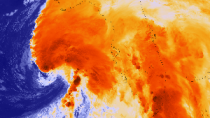
Suomi NPP satellite peers into Tropical Storm Andrea, the first storm of the season. (Credit: NOAA/NASA)
Tropical storm Andrea, the first of the season, was the only named storm to make landfall in the United States this year. Andrea brought tornadoes, heavy rain, and minor flooding to portions of Florida, eastern Georgia and eastern South Carolina, causing one fatality.
The 2013 hurricane season was only the third below-normal season in the last 19 years, since 1995, when the current high-activity era for Atlantic hurricanes began.
“This unexpectedly low activity is linked to an unpredictable atmospheric pattern that prevented the growth of storms by producing exceptionally dry, sinking air and strong vertical wind shear in much of the main hurricane formation region, which spans the tropical Atlantic Ocean and Caribbean Sea,” said Bell. “Also detrimental to some tropical cyclones this year were several strong outbreaks of dry and stable air that originated over Africa.”
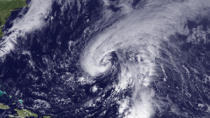
GOES East satellite tracks Subtropical Storm Melissa, the last storm of the season. (Credit: NOAA)
Unlike the U.S., which was largely spared this year, Mexico was battered by eight storms, including three from the Atlantic basin and five from the eastern North Pacific. Of these eight landfalling systems, five struck as tropical storms and three as hurricanes.
NOAA and the U.S. Air Force Reserve flew 45 hurricane hunter aircraft reconnaissance missions over the Atlantic basin this season, totaling 435 hours, the fewest number of flight hours since at least 1966.
NOAA will issue its 2014 Atlantic Hurricane Outlook in late May, prior to the start of the season on June 1.
=========
No mention of the failure of the predictions in 2013, nor the fact that this year goes against wild claims made by alarmists of increasing hurricanes due to global warming, something Pielke Jr. also illustrates with a new graph:
The graph below shows total US hurricane landfalls 1900 through 2013.
The five-year period ending 2013 has seen 2 hurricane landfalls. That is a record low since 1900. Two other five-year periods have seen 3 landfalls (years ending in 1984 and 1994). Prior to 1970 the fewest landfalls over a five-year period was 6. From 1940 to 1957, every 5-year period had more than 10 hurricane landfalls (1904-1920 was almost as active).
The red line in the graph above shows a decrease in the number of US landfalls of more than 25% since (which given variability, may just be an artifact and not reflecting a secular change). There is no evidence to support more or more intense US hurricanes. The data actually suggests much the opposite.
Dr Ryan Maue adds:
Here’s a sorted list of North Atlantic hurricane ACE numbers from 1950-2013 - this year tied for 5th lowest on record
------------
By the way the tornado season was the quietest on record and the wildfire season the quietest since 1985 when the current monitoring method began.
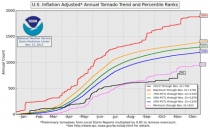
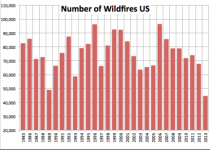
Meteorologists and other atmospheric science experts are playing important roles in helping society respond to climate change. Members of this professional community are not unanimous in their views of climate change, and there has been tension among members of the American Meteorological Society (AMS) who hold different views on the topic.
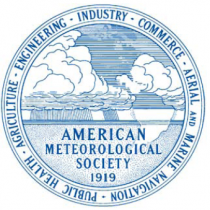
In January 2012, the AMS surveyed its members via email and found 52 percent believe global warming is happening and is mostly human-caused, while 48 percent do not. The survey also found that scientists with professed liberal political views were far more likely to believe global warming is human-caused than others.
Authors of the survey recommended that the AMS should “acknowledge and explore the uncomfortable fact that political ideology influences the climate change views of meteorology professionals; refute the idea that those who do hold non-majority views just need to be “educated” about climate change; [and] continue to deal with the conflict among members of the meteorology community.”
The “early online release” of the survey, to be published in the Bulletin of the American Meteorological Society, is available for free viewing
I did an informal survey of 30 professional AMS member known to be skeptics. I was not surveyed. Only 2 received and one responded to the survey. There were weasal worded questions as is typical of surveys in which Ed Maibach is involved. One of those who have advocated a more open approach among the 30, Mike Smith says it like it is. “I am a Fellow of the American Meteorological Society and a Certified Consulting Meteorologist. To the best of my memory I never had a chance to respond to this poll of the AMS membership.
That said, the fact that 70% of scientists say that humans affect the climate is utterly unsurprising. That has been known scientifically since Changnon’s METROMEX study in the early 70’s. The fact that 9 out of ten that publish on the subject of climate believe humans affect the climate is also utterly unsurprising.
For me, the money question was #6, “How worried are you about global warming?” Only 30% answered “very worried.” This would make 70% of the respondents “deniers” since that pejorative term seems to be applied to anyone who does not accept the “IPCC consensus” of catastrophic global warming. A statistically similar number (28%) is not worried or “not very worried” about global warming.
So, you can spin the results any way you want but this survey of a small number of AMS members doesn’t reveal any great concern about global warming.”
I could add a long list of former active professional members including fellows who have left the society because of their stance on climate change. I have kept my powder dry and stayed in the society hoping to be around to pick up the pieces when the lies are openly exposed and the scam collapses.
by Neil Frank and E. Calvin Beisner, November 20, 2013
Super Typhoon Haiyan and the anniversary of Superstorm Sandy should remind all of us of the tragic suffering that is part of living in the post-fall world, affected by both human sin and the divine curse (Genesis 3).
But is Rev. Darren A. Ferguson, of Mount Carmel Baptist Church in Far Rockaway, NY, whose home and church Sandy destroyed, right to insist that “climate change” made Sandy stronger than it otherwise would have been?
Assume for a moment (though there is good reason to doubt it) that the world’s been warming rapidly and beyond the bounds of natural variability and that, as he put it, “we are the primary cause.” Does that entail that Sandy was more powerful because of it?
Contrary to Rev. Ferguson’s claims, the United Nations Intergovernmental Panel on Climate Change (IPCC) denies that there is good evidence that global warming, manmade or not, causes greater frequency or intensity of hurricanes. In its 2012 special report on extreme weather events it said, “There is low confidence in any observed long-term (i.e., 40 years or more) increases in tropical cyclone activity (i.e., intensity, frequency, duration), after accounting for past changes in observing capabilities.” In its just-released Fifth Assessment Report, it said, “Current datasets indicate no significant observed trends in global tropical cyclone frequency over the past century...No robust trends in annual numbers of tropical storms, hurricanes and major hurricanes counts have been identified over the past 100 years in the North Atlantic basin.... In summary, confidence in large scale changes in the intensity of extreme extratropical cyclones since 1900 is low.”
Nonetheless, it’s widely thought that even if global warming didn’t cause Sandy, it did make it worse a stronger or bigger storm, or with storm surge exacerbated by global warming-driven sea level rise. What of those ideas?
Did higher sea level caused by global warming make Sandy’s storm surge more devastating? No. Land subsidence and natural sea level rise, both happening ever since the Ice Age, account for all of the apparent sea level rise at Battery Park in New York City.
In fact, as geoscientist David Middleton reports, Sandy’s “storm surge was likely surpassed in the New England hurricanes of 1635 and 1638” and “at least seven hurricanes of intensity sufficient to produce storm surge” greater than 3 meters “made landfall in southern New England in the past 700” years. All seven occurred prior to 1960 before manmade global warming. In 1821, at low tide and with sea level a foot lower than today, a Category 3 hurricane brought a 13.9 foot storm surge to New York City. The same storm today, hitting at high tide, as Sandy did, would have caused much greater flooding than Sandy did.
Was Sandy bigger or stronger because of global warming? In strength, Sandy never exceeded Category 3 (out of 5) and was actually no longer a hurricane but only a post-tropical storm when it made landfall at Atlantic City. The diameter of Sandy’s gale-force wind field was greater than any Atlantic hurricane in recorded history but only by about 3% and for this measure “recorded history” reaches back only to 1988.
Rev. Ferguson says those who disagree that manmade global warming was to blame for Sandy “would have trouble explaining the fact that in this New York City peninsula where I live and pastor a church, the Atlantic Ocean and Jamaica Bay had not met in over 50 years” before Sandy. But if they met 50 years ago, before any significant manmade global warming, why invoke it to explain their meeting last year?
While at the time those who blamed Sandy on global warming included a handful of climate scientists (Kevin Trenberth, whom Rev. Ferguson cites, plus Katharine Hayhoe and James Hansen, none of whom is a hurricane specialist), they also included nonscientists (Al Gore, Joe Romm, Bill McKibben, Chris Mooney, Roseann Barr, Michael Oppenheimer, Jennifer Granholm, Van Jones, Chris Matthews, Bill Clinton, Stephan Lewandowsky, and Michael Moore).
Although those who disagreed include a handful of what Rev. Ferguson calls (when they disagree with him) “know-it-all pundits, who lack any scientific credentials” (Limbaugh; UK Telegraph science writer Tom Chivers; New York Times environment blogger Andrew Revkin), most are scientists. Two, though not climate scientists, specialize in climate change (Norman Page, a consulting geologist; Eric Berger, science writer for the Houston Chronicle). Most are climate scientists (Martin Hoerling, National Oceanic and Atmospheric Administration; Roger Pielke Jr., University of Colorado; Karsten Brandt, Donnerwetter.de; Patrick Michaels, formerly University of Virginia, now Cato Institute; Judith Curry, Georgia Tech; Gerald North, Texas A&M; Roy Spencer, formerly NASA, now University of Alabama), and four are hurricane specialists (Chris Landsea and Stanley Goldenberg, National Hurricane Center; Ryan Maue, Florida State University; and William Gray, Colorado State University).
As NHC’s Goldenberg put it in an email to Dr. Beisner, “If someone says Sandy was stronger due to AGW, that goes against even the current hurricane climate studies which suggest that in the future, there could be a very slight increase in intensity for the stronger storms… although Sandy was strong for that region, it was by no means among the strongest Atlantic hurricanes. As for increased flooding due to sea-level rise firstly the total sea-level rise since the great 1938 Hurricane is only about 7 inches, and about 1/2 of that is due to land subsidence. Of the other several inches, some would certainly be due to natural climate fluctuations (especially the natural warming since the end of the Little Ice Age in the mid-1800’s) and if there is any contribution from AGW, it would be at the most on the order of a few inches. Compared to the contribution from the lunar high tide and the actual storm surge (together totaling 10 to 17.5 feet in the hardest hit regions), these few inches… are hardly significant.”
Rev. Ferguson claims “97% of scientists agree that climate change is real and we are the primary cause.” He says “Rush Limbaugh and other climate change deniers” “recklessly deny climate change because [doing so] confirms their ideology and advances their agenda.”
Although Dr. Beisner has read about forty-five books on the science of climate change, large parts of all five IPCC assessment reports, and thousands of articles on it over the past twenty-five years, and consults regularly with climate scientists, he’s not a climate scientist, so Rev. Ferguson can, as he does with others who disagree, write him off as one of the “know it all pundits, who lack any scientific credentials” - on condition that he write himself off as well. But he can’t write off Dr. Frank, for he is a Ph.D.’d meteorologist and former director of the National Hurricane Center.
What about Ferguson’s claim that “97% of scientists agree that climate change is real and we are the primary cause”?
Science isn’t about consensus, it’s about evidence and reasonable explanations.
Consensus among scientists has changed radically, and repeatedly, in the past as, for instance, from nearly universal rejection to nearly universal acceptance of continental drift.
As Georgia Tech climatologist Dr. Judith Curry has shown, such “consensus” as there is among IPCC and other global warming true-believer scientists is worthless because it was intentionally constructed, not spontaneous.
The publication survey on which the 97% claim rests had such broad criteria (e.g., not specifying that people are the primary cause or that the warming was dangerous, let alone catastrophic) that it would have counted most critics of CAGW (catastrophic, anthropogenic global warming) as in agreement. As Dr. Roy W. Spencer, an award-winning NASA climate scientist and Cornwall Alliance Senior Fellow, put it recently on CNN, “I’m one of the 97%!” Both of us would be, too. In reality, while repeated attempts have been made to prove a consensus on dangerous, manmade global warming, none has succeeded as if it would matter if they did (see 1 above).
In short, Rev. Ferguson is wrong to blame “climate change deniers” (the pejorative term meant to equate them, viciously, with Holocaust deniers) for global warming and to blame global warming for Sandy’s size, strength, and devastation.
If Rev. Ferguson is going to call natural disasters divine judgments, he should, as the Bible often does (e.g., Genesis 19; Exodus 7-14; Psalm 107:33-34; Isaiah 35:6-7; Jeremiah 14; Zephaniah 1:2-3), attribute them to sins clearly revealed in God’s law - worshiping false gods, idolatry, blasphemy, Sabbath breaking, dishonoring parents, murder, adultery, theft, false witness, and coveting (Exodus 20:1 -17) - not burning fossil fuels to provide energy to lift billions out of poverty, disease, and premature death.
Rather than assigning blame, though, we would do better to reduce the risk of future catastrophes by eliminating policies, like government-funded flood insurance, that encourage construction in high-risk shoreline locations. What made Sandy and Haiyan so devastating was not their size and strength (many surpassed them) but where they struck: densely populated regions with vast amounts of property on vulnerable shorelines.
And when people are harmed, we should act compassionately: We should pray for and donate to their rapid recovery. We should pray that the Christians among them will come to understand, as they seek God in the midst of their suffering, how God works it for their good (Romans 8:28); that it is not worthy to be compared with the glory that will be revealed to them (Romans 8:18); indeed, that “this slight momentary affliction is preparing for [them] an eternal weight of glory beyond all comparison, as [they] look not to the things that are seen but to the things that are unseen. For the things that are seen are transient, but the things that are unseen are eternal” (2 Corinthians 4:17-18). And we should pray that the unbelievers will become Christians, lest after this life they enter upon suffering that will make Sandy and Haiyan seem like paradise.
[A slightly modified version of this article was published in The Christian Post Tuesday, November 19, 2013.]
Neil Frank, Ph.D., a meteorologist, is former Director (1974-1987) of the National Hurricane Center, former Chief Meteorologist of Houston CBS affiliate KHOU-TV (1987-2008), and an evangelical Christian. E. Calvin Beisner, Ph.D., author of Where Garden Meets Wilderness: Evangelical Entry into the Environmental Debate, is Founder and National Spokesman of The Cornwall Alliance for the Stewardship of Creation, a coalition of evangelical theologians, pastors, ministry leaders, scientists, economists, policy experts, and committed laymen promoting environmental stewardship and economic development built on Biblical principles.





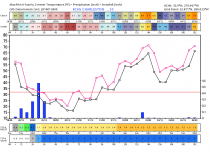
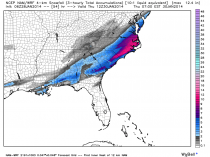
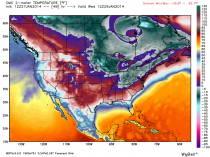
_thumb.png)
